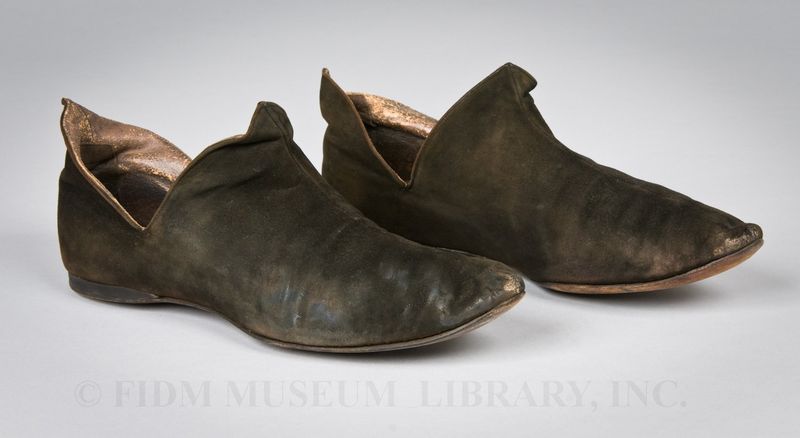Leather booties worn by Ingrid Bergman in Joan of Arc
When Joan of Arc was released in 1948, Ingrid Bergman was already a star. Born in Sweden in 1915, Bergman starred in several Swedish stage and screen productions before her 1939 American debut in Intermezzo. An English-language adaption of a Swedish film, Intermezzo featured Bergman reprising her role as Anita, a piano teacher who pulls concert pianist Holger (Leslie Howard, also known as Ashley in Gone With the Wind) away from his family. Bergman's next major role was in Casablanca (1942), now considered a cinema classic. Throughout the 1940s, Bergman starred in a string of successful films: For Whom the Bell Tolls (1943), Gaslight (1944), and the Hitchcock films Spellbound (1945), and Notorious (1946). In 1947, Life magazine claimed: "polls have rated her No. 1 feminine star of the year."1
In 1947, Ingrid Bergman made a move to the New York stage, playing the title role in Joan of Lorraine by Maxwell Anderson. Constructed as a play within a play, Joan of Lorraine tells Joan of Arc's story through a contemporary staging of her remarkable story. For her onstage portrayal of Joan of Arc, Bergman won a Tony Award. Bergman had wanted to play Joan of Arc for many years, and her investment in the role led to her involvement with the 1948 film Joan of Arc. Based on Joan of Lorraine, the 1948 cinematic version of Joan of Arc is a straightforward retelling of Joan's saga. Broadly summarized, Joan of Arc was a 15th century peasant girl who heard voices. According to Joan, these voices were saints telling her she must lead the decimated French army to victory over the occupying English. Historical record indicates that Joan existed, and did actually serve as a figurehead and/or military strategist during a series of remarkable military victories in the early 15th century. In 1431, she was burned at the stake by a faction sympathetic to the English occupation.
 Worn by Ingrid Bergman in Joan of Arc, 1948
Worn by Ingrid Bergman in Joan of Arc, 1948
Designer: Dorothy Jeakins
Maker: La Ray Footwear
Leather
Department of Recreation and Parks, City of Los Angeles/FIDM Museum
L88.1.190AB
Karinska and Dorothy Jeakins share credit for Joan of Arc's costumes. Karinska was a Russian emigre closely associated with dance costumes. Before coming to the United States, she designed stage costumes for a 1930s incarnation of the Ballets Russe, the Ballet Russe de Monte Carlo. After moving to the United States in the late 1930s, she costumed a handful of Hollywood films, but focused primarily on dance costumes. The same year Joan of Arc was released, Karinska became the costume designer for the newly founded New York City Ballet.
In contrast, Joan of Arc was Dorothy Jeakins first film. Born in southern California in 1914, Jeakins' upbringing was colored by the economic hardships of the Depression. After graduating from Fairfax High School, she was awarded a scholarship to the Otis Art Institute, a Los Angeles art college. During the 1930s, she was involved with the Los Angeles branch of the Federal Art Project, where she received training in printmaking, painting and other media. Her artistic skills led to a sketching position at I.Magnin, which led a job as costume designer for Joan of Arc.
Joan of Arc's costumes are inspired by medieval dress. This pair of elf-like leather booties are worn by Ingrid Bergman at the beginning of the film, when she is still dressed as a peasant. This incarnation of Joan is short-lived; she spends most of the film in a suit of silver armor. Based on examples of medieval armor, this armor was fashioned for Bergman by staff from the Arms & Armor department of the Metropolitan Museum of Art. In 1948, it was displayed at the Met with a portrait of Bergman as Joan of Arc.2
Determining the extent of the collaboration between Karinska and Jeakins requires more research. Jeakins may have been hired to fabricate Karinska's designs, or to secure costume elements from various manufacturers. Whatever the nature of their collaboration, it was successful. In 1949, Karinska and Jeakins were awarded an Oscar for Best Costume Design in a color film for their Joan of Arc costumes.
Despite this win, and 6 other nominations, Joan of Arc wasn't a fantastic commercial success. Though some critics praised the film, others suggested that the costumes and sets were more magnificent than the story or the acting. Ingrid Bergman's affair with Italian film director Roberto Rossellini, revealed just as Joan of Arc went into wide-release, probably didn't help either. In today's media climate, this kind of revelation might bolster attendance, but in the late 1940s, the Bergman/Rossellini affair was a true scandal. Because of this relationship, Bergman was denounced on the Senate floor, and blackballed from American cinema. She didn't star in another American-made film until 1957, when she played the title role in Anastasia.
1 Barnett, Lincoln. "Ingrid of Lorraine: The Complicated Personality of Miss Bergman is Examined by Herself and Her Friends." Life 24 Mar. 1947: 119.
2 "Armor Suit to be Shown." New York Times 9 Sept. 1948: 33.